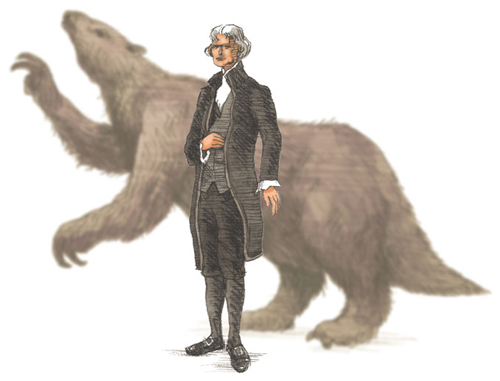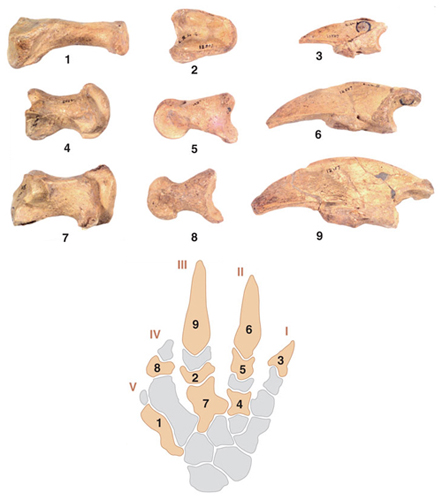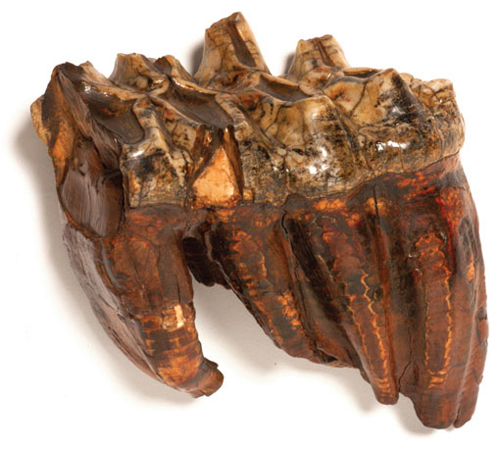Jefferson's Old Bones
By Keith Thomson
Did the so-called father of American vertebrate paleontology believe in fossils?
Did the so-called father of American vertebrate paleontology believe in fossils?

DOI: 10.1511/2011.90.200
In April 1836, the naturalist John Kirk Townsend wrote from Vancouver to the physician Samuel G. Morton in Philadelphia, to report that a group of Indians had told him of seeing
a quadruped of a gigantic size which from the description appeared to resemble the supposed extinct Mastodon. They said it was about the height of one of their houses (not less than 30 feet), and that it was of a brownish or blackish color, & appeared almost destitute of hair.… This story was substantiated by the whole party, & some individually did not hesitate to strengthen their affirmations by the most solemn oaths.

Illustration by Tom Dunne.
Similar tales of strange monsters roaming the western lands of the continent had been common in the previous century. A nice example is given in the journal of James Kenny, a frontier trader who worked for the Commissioners for Indian Affairs, from 1761:
the Rhinosses or Elephant Master, being a very large Creature of a Dark Colour having a long Strong horn growing upon his nose (wth which he kills Elephants) a Short tail like an Elk; two of sd horns he seen fixd over a Gate at St Augustine, & that its ye bnes of Some of these lies down in Buffelo lick by ye Ohio, wher ye Great teeth Comes from.
Thomas Jefferson avidly collected such accounts as they were important for his view of science. Jefferson did not believe in extinction. He was particularly fascinated by the American mastodon, the elephant relative that he referred to for many years as “the mammoth.” It was not until 1806 in Paris that the French naturalist Georges Cuvier formally separated “mastodonte” from mammoth and also concluded that there were two living species of elephant. But in his Notes on the State of Virginia (1785), Jefferson had already concluded that the cold-adapted “mammoths” were different from the living tropical African and Asian elephants. Over many years he amassed a large collection of “mammoth” remains, which he displayed in the entrance hall of Monticello, his great house in Virginia.
Jefferson’s second great paleontological interest arose in 1799 when he was sent some bones of a huge mammal “of the clawed kind” that had been found in a cave in Greenbrier County (in present-day West Virginia). He described this creature in his writings and named it Megalonyx (“great claw”). Jefferson was sure that this creature also still lived and, as is well known, he very much hoped that the Lewis and Clark Expedition of 1804–1806 would find evidence of both living mastodons and Megalonyx in the American West. He was therefore pleased when, soon after he completed his study of Megalonyx for publication in 1799 in the Transactions of the American Philosophical Society, a correspondent informed him:
Some circumstances have lately been related to me which in my opinion go far in support of your conjecture that the species of Animal whose Bones were found in Green, still exists in the Western Country…. far up the Misouri river in which an Animal is found of a brown colour, much larger than a Bear, of astonishing strength, activity, & fierceness … a Nail [was] taken from the Claw of one killed by the party of Indians to which he belonged but not before it had torn several of them into pieces. This Nail or horny part of the Claw is said to measure six inches in length.
For his analysis of the mastodon and description of Megalonyx, historians have often called Jefferson the father of American vertebrate paleontology. Sixty-five years ago, however, paleontologist George Gaylord Simpson, in a masterly review of the history of American vertebrate paleontology, argued that Jefferson did not deserve this accolade because his actions were not sufficiently scientific. Simpson points out that Jefferson did not believe in extinction partly on religious grounds, and in his paper on Megalonyx, he started with a theory (that the animal was some kind of gigantic American lion) and then tried to prove it, rather than first assembling the facts. Both of these charges are true. But the situation turns out to be rather more complicated than Simpson thought.

Ted Daeschler/Academy of Natural Sciences
Illustration adapted by Tom Dunne from a drawing by Dennis Murphy/Academy of Natural Sciences.
The first defense against Simpson’s charge is that Jefferson’s views on extinction were not simply, and certainly not only, a matter of religious prejudice—although it is true that Jefferson was a deist who thought that the Creator had made the world just once, and as it is now. He wrote to John Adams in 1823 of his beliefs:
The movements of the heavenly bodies, so exactly held in their course by the balance of centrifugal and centripetal forces, the structure of our earth itself, with its distribution of lands, waters and atmosphere, animal and vegetable bodies, examined in all their minutest particles, insects mere atoms of life, yet as perfectly organized as man or mammoth, the mineral substances, their generation and uses, it is impossible, I say, for the human mind not to believe that there is, in all this, design, cause and effect, up to an ultimate cause, a fabricator of all things from matter and motion, their preserver and regulator …
In fact, Jefferson did recognize the obvious fact that species and populations—such as the wolf and bear in Britain, or various American Indian groups—became extinct. He also believed that nature compensated for such losses. The sentence quoted above continues, “while permitted to exist in their present forms, and their regenerator into new and other forms.” Furthermore, in the same letter he wrote:
We see … evident proofs of the necessity of a superintending power to maintain the Universe in its course and order … Certain races of animals are become extinct; and, were there no restoring power, all existence might extinguish successively, one by one, until all should be reduced to a shapeless chaos.
As for the mastodon and Megalonyx, Jefferson, the lawyer, simply argued “the bones exist; therefore the animal has existed.… If this animal then has once existed, it is probable … that he still exists.” But he also argued like a scientist. In his paper on Megalonyx he devoted a full four (out of 14) pages to reports from western travelers of encounters like those cited above. In this sense, his view of extinction can be seen as a hypothesis for which he cited evidence in support.
A more difficult question concerns Jefferson’s understanding of what his mastodon and Megalonyx bones actually were. It is impossible to open any work about Jefferson and his collections without finding a reference to Jefferson’s love of “fossils.” But a careful search of Jefferson’s writings (now made possible by the availability of searchable databases) reveals the surprising fact that he never referred to them as fossils. For him they were always simply “bones.” The word “fossil” does not appear in Notes on the State of Virginia or his letters.
In Jefferson’s day, the word “fossil” was undergoing a change of meaning. Prior to the mid-18th century, “fossil” (from its Latin root, fossere, to dig) referred to anything dug up out of the ground. Thus coal, diamonds, metal ores, asphalt and the remains of once-living creatures were all called fossils. Then in works such as John Woodward’s Fossils of all Kinds, Digested into a Method Suitable to their Mutual Relation and Affinity (1728) two different categories came to be distinguished: native fossils (minerals and metals) and extraneous fossils. The latter was restricted to the remains of once-living creatures, petrified and preserved in the rocks. Eventually the various elements of native fossils all found their own separate names and the term extraneous fossils (and sometimes adventitious fossils), was reduced simply to “fossils,” remained for the organic remains. From then, it was used both as a noun and an adjective. Thus in 1758, physician John Fothergill reported on “the fossile bones of an Allegator” from Whitby in Yorkshire, England, and anatomist William Hunter, writing about remains from Big Bone Lick in America in 1768, called them “fossil tusks.” Botanist Peter Collinson the same year referred to “very large Fossil Teeth” from the same source.

Ted Daeschler/Academy of Natural Sciences
It is important to note, however, that at first the definition of something as a fossil did not necessarily imply great age; the whole Earth, in conventional thinking, was only 6,000 years old. But, in that context, something 5,000 years old was ancient indeed. This still left the problem of discovering how petrification occurred and how fossils were formed—how “the stoney Atoms have intruded themselves into all parts alike,” as Robert Plot put it in his 1677 publication Natural History of Oxford-shire.
In America the transition to the new set of meanings was patchy. In 1771 the American Philosophical Society proposed the creation of a new museum containing “all Specimens of Natural Productions, whether of the ANIMAL, VEGETABLE or FOSSIL Kingdoms.” A decade later, philosopher Pierre Eugene du Simitière advertised his “American Museum” in Philadelphia as including “Artificial Curiosities” (such as portraits and machines) and “Natural Curiosities.” The latter included “Marine Productions” (fishes and the like), “Land Productions” (birds and insects, for example), “Fossils” (used in the old sense of minerals and salts) and “Petrifications.” This last category included both what we now call fossils (such as bones, shells, teeth and corals) as well as a number of inorganic categories such as “fossil substances produced by the eruptions of Volcanos.” As late as 1792, when painter and naturalist Charles Willson Peale proposed his new museum for Philadelphia, he wrote that it would include “the fossil kingdom, comprehending the earths, minerals, and other fossil matters, which include petrefections.” All three projects set a line between objects that belonged to living organisms and those that were petrified.
An obvious logical difficulty created by such classifications was that an object such as a mastodon femur could be classed either as a bone or a fossil, but it could not be both. In this situation, anything that recognizably belonged to a vertebrate skeleton, even if petrified, was preferentially referred to as a “bone” or “tooth.”
A modern usage of the word fossil appeared in the minutes of the American Philosophical Society in 1784, when a collection of Big Bone Lick fossils collected by a Major Craig was described as “petrified bones.” The 1799 volume of the American Philosophical Society Transactions, which included Jefferson’s Megalonyx paper, also had a contribution from a land speculator, Judge George Turner, in which bones from Big Bone Lick were termed “extraneous fossils.” In a 1796 letter to his cousin Philip Turpin—a farmer whose land became an archeological site—Jefferson himself referred to an unspecified “petrified Bone in my possession” (evidently not part of his Megalonyx suite). Several of Jefferson’s correspondents in the 1780s and 1790s used the word fossil in its current sense. He was also familiar with the fossil shells (possibly Silurian brachiopods) that could be found in the Blue Ridge Mountains of Virginia and freely referred to them as petrified but, again, not as fossils.
Jefferson’s consistent failure to use the word in his more formal writings almost seems like deliberate avoidance. That impression is strengthened by the only two cases that I have discovered of Jefferson actually mentioning the word. In 1807 he hired William Clark to head back to the Ohio territory and make a large collection of bones from Big Bone Lick, the famous site from which all the great mastodon remains had been recovered (before Peale’s then-recent excavations in New York State). When first formally commissioning Clark, Jefferson referred only to collecting “bones.” When he thanked him for the results two years later, he also wrote of “bones.” But in his private account book he made a different annotation. The entry for February 9, 1808, reads: “Gave ord. on bank US. In favr. Genl. Wm. Clarke for expenses digging fossil bones.” There is a similar notation for November 2 of that year where he used the French spelling “fossile.”
At the very least these entries tell us that Jefferson recognized the status of some remains as having been “dug up,” but from his other writings it is not at all clear that Jefferson thought that his mastodon and Megalonyx remains were actually petrified. He wrote that the Megalonyx remains showed “a small degree of petrification” in addition to being preserved by impregnation by “nitre” from the cave floor. He may even have doubted whether elements found in a marsh or on a cave floor qualified as having been “dug up.”
It is inappropriate to judge Jefferson, as Simpson did, by our own standards, and many a great scientist turns out to have been (in our estimation) wrong some of the time. Nonetheless, as is often the case with Jefferson, a puzzle remains. Did he deliberately avoid using the word “fossil” in reference to the mastodon and Megalonyx? If so, did he do it as a lawyer and for strategic, rhetorical reasons, or as a scientist, or as both? From our modern point of view, the dilemma Jefferson faced is easy to outline. There was no consensus on how petrifaction occurred, how long it took, and indeed, how sea shells came to be found high up in mountains, how mountains were formed or how old the Earth was. And there was no unanimity about whether extinction was a real phenomenon. In each of these questions, some contemporary philosophers were edging toward modern solutions, whereas others were exploring versions of a flood theory or hypothesizing about impacts with comets. Jefferson, aware of the trends, evidently found his ideas and information to be in conflict.
From a religious point of view, Jefferson did not want to accept extinction, but there was also enough anecdotal evidence to suggest that Megalonyx, at least, might still be alive in the west to support him in that conclusion. He was unsure to what extent his “bones” were petrified. It seems that his solution was to be extremely careful in his word usage. As a master of language and of precise use of rhetoric, Jefferson seems to have kept his options open by simply avoiding use of the word fossil and by sticking to terms whose meaning was precise and unequivocal. By referring to the fossils of mastodon and Megalonyx (which in any case, we now know were only 8,000 to 12,000 years old) simply as bones, tusks and teeth, he wrote with strict accuracy and preserved his philosophical position.
With his perceptive analysis of the mastodon and other elephants in Notes on the State of Virginia and his account of Megalonyx, Jefferson made significant contributions to scientific knowledge. He certainly encouraged the discovery and study of fossils by people such as Charles Willson Peale and physician Caspar Wistar (whose own analysis of Megalonyx, published alongside Jefferson’s, was a masterpiece of forensic anatomy). Jefferson was misled by his hopes that the mastodon and Megalonyx were mighty ferocious carnivores that would symbolize American vigor (and contradict European claims of the inferiority of American wildlife), but he was in many ways the progenitor of our modern fascination with another set of monsters from the west—dinosaurs. In these respects, he can fairly be considered a founder of American vertebrate paleontology. But the irony remains that he helped found a discipline without having accepted two of its fundamental premises: fossils and extinction.
Click "American Scientist" to access home page
American Scientist Comments and Discussion
To discuss our articles or comment on them, please share them and tag American Scientist on social media platforms. Here are links to our profiles on Twitter, Facebook, and LinkedIn.
If we re-share your post, we will moderate comments/discussion following our comments policy.